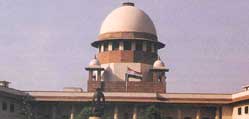Courting green
 ON FEBRUARY 10 this year, Machu Dandavate, the deputy chairperson of the planning commission, underlined the reason behind a phenomenon which has lately taken the country by stem. Judicial activism - the intervention of the judiciary to stem the rot, especially in the field of environment and its protection - is the byword today. Addressing a seminar in Vellore Engineering College, Tamil Nadu, Dandavate squarely blamed the 'non-activism' of the executive and the legislature for forcing the judiciary to step in.
ON FEBRUARY 10 this year, Machu Dandavate, the deputy chairperson of the planning commission, underlined the reason behind a phenomenon which has lately taken the country by stem. Judicial activism - the intervention of the judiciary to stem the rot, especially in the field of environment and its protection - is the byword today. Addressing a seminar in Vellore Engineering College, Tamil Nadu, Dandavate squarely blamed the 'non-activism' of the executive and the legislature for forcing the judiciary to step in.
From the oil one fills in his or her car to the attempts to save the Taj from air pollution - the long hand of the judiciary has been reaching out everywhere, shaking the very foundations of the nation in the process. The year 1996 had seen a rush of environmental judgements (see box. Boiling point). May be it was not entirely coincidental that Justice Kuldip Singh's (the 'green judge') term as a judge in the apex court expired at the end of the year. In his final year in office, the learned judge was particularly active in meting out punishment to environmental 'goons'. In fact, a section of environmental lawyers believes that the courts betrayed a distinctly pro-industry attitude before Singh appeared. Colin Gonsalves, a Mucabai High Court advocate who has been involved in environmental litigation for several years, says, "There is no guarantee that the courts will not revert to their earlier industry-friendly attitude. Unfortunately, such inclination of the courts is almost entirely dependant on the judge involved."
The Indian officialdom's apathy is legion. Despite being armed with information and powers that could lead to immediate action, agencies entrusted with ensuring that the country's rivers, lakes, coastlines and forests were protected have repeatedly failed in their duties. Now, besieged by directives from the courts, then agencies and departments have been rudely awakened from their stupor and pushed into a hitherto unheard of arena: that of accountability. In Bichhri, for instance, the Rajasthan pollution control board had failed to bring to public notice that effluents from the units producing m-acid, a chemical, had poisoned the groundwater and the aquifer. With the courts showing a sudden interest in environmental issues, such agencies had no option but to make public their findings. None has been spared; in a use involving import of hazardous wastes, N R Krishnan, the then secretary, ministry of environment and forests (MEF), was severely rebuked by the apex court.
The reaction has been predictable. The highest offices in the land have initiated steps to put an end to the citizen's approach to courts. But the judicial juggernaut troubles on, shattering the popular belief that in the contest between environment and employment, the latter always wins. The courts have been understanding, though; most of their orders have carried directives that workers be adequately compensated. At the same time, the messsage to polluting industry has been clear: shape up, or shut down.
There have been instances, though, when many have felt that they got a raw deal from the courts. "There have been murmurings of dissatisfaction," says Rajeev Dhawan, a senior Supreme Court (SC) advocate involved with environmental litigations for some years. The manner in which some decisions were arrived at often reminded one of a swashbuckling entity." Also, the belief that the SC had become a first resort rather than being the last, has grown. Former Chief justice of India, P N Bhagwati, agrees: "In disputes, the first trial action should not be before the SC, but a tribunal. Mass orders arrived at by the SC leave many of the affected parties with the feeling that they have not been heard."
While there is no doubt that the orders passed were all to good effect, the decisions taken have left a lot to be desired. Most importantly, the courts seem to have let off the pollution monitoring agencies very lightly. The present situation of a grossly threatened environment has come about as these agencies, charged with ensuring that industry operated within the prescribed rules, had abdicated their duties. And the courts seem to have almost missed the point in not directly addressing this failure. Also significant is the question whether the courts art qualified to take decisions that executive agencies should have taken. Shouldn't these very executive agencies he the ones to be penalised first fur failing to do their duty? In the following pages, Down To Earth examines four representative cases - Bichhri (Rajasthan), Patancheru (Andhra Pradesh), the Delhi ridge and the Span Resorts in Kullu (Himachal Pradesh) - to study the efficacy of court decisions in environmental litigation.
Related Content
- Order of the National Green Tribunal regarding an illegal cracker unit in Thanjavur district, Tamil Nadu, 29/05/2025
- Order of the National Green Tribunal regarding pollution of Godavari river, Telangana, 29/05/2025
- Order of the National Green Tribunal regarding dumping of waste in a canal in Chennai, Tamil Nadu, 29/05/2025
- Order of the National Green Tribunal regarding violation of environmental norms by a tyre pyrolysis plant, village Sakauti, Shamli, Uttar Pradesh, 28/05/2025
- Order of the National Green Tribunal regarding waste disposal in Ghazipur drain, Delhi, 28/05/2025
- Order of the National Green Tribunal regarding poor handling of the fly ash by Rajiv Gandhi Thermal Power Plant, Khedar, Hisar district, Haryana, 27/05/2025
